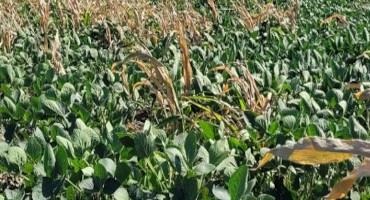By Heather Gessner
Dry weather conditions during the 2021 corn growing season have left their mark on the 2022 soybean crop. Many producers are facing abnormally high concentrations of volunteer corn due to the small ears that did not get pulled into the combine last fall.

While herbicides are available to combat the issue, the lost production in some areas will be noticeable. An alternative to relying on herbicides is the inclusion of a fall grazing program.
Fall aftermath grazing by livestock, particularly cows, dramatically reduces the amount of volunteer corn in the field, as cows generally consume the ears, leaves and husks first (Reduce Feed Cost by Grazing Corn Stalks).
Grazing can also provide an income source for the operation. If the cattle are your own, the income comes from feed savings, while the animals gain weight and body condition. If you rent out the acres, cash rent will come in and also reduce the herbicide needs in 2023 to combat volunteer corn.
Concerns
Issues related to compaction from cattle grazing acres are a common reason producers do not allow grazing. However, studies have shown no yield losses the following year due to grazing those acres. The University of Nebraska did a multi-site study that showed no change in the next year's corn yields and an increase in the following year's soybean yields in a corn-soybean rotation (Grazing Residue: Having Your Cake and Eating It Too).
Water availability and fences are other concerns. Water issues can be alleviated through temporary water sources and hauling or installing permanent water facilities if grazing the area becomes a yearly activity. Likewise, the lack of fence can be covered with the use of solar, electric fences, updating the remaining fence, or installing a permanent fence if the location is going to be used every year.
Fees
Determining a rental rate depends on the amount of feed available. Rates over the past years have been in the $0.50 to $1.20 per head per day range, depending on the price of corn, corn yield, water availability and fence situation. The livestock owner also prefers the per-day rate, as winter weather can unexpectedly shorten the grazing season with ice or snow.
The value of the corn in the field is reflected in the per bushel price of corn. Even on the ground, the feed is valuable to the cattle budget. Corn yield is directly related to the amount of feed available to the cattle. High-yielding corn leaves more leaves, husks and stalks in the field than low-yielding corn. The more feed available, the longer the cattle can graze those acres, or the more animals can be put on the field for a shorter time.
Stocking Rates
Stocking rates will vary by producer. For example, the cattle owner may want a high stocking rate on a field a long distance from their home base. This way, the cattle can cover the acres, reduce the amount of cover left in the area in a short amount of time, and then be moved closer to home before a bad weather situation may occur.
When determining the stocking rate, the number and weight of the animals, corn yield, number of acres and the anticipated days on the field must be considered. The last component of the formula is the harvest efficiency of the grazing animals. Generally, a 50 percent reduction in the aftermath is used for grazing efficiency. If cattle consume more than 50% of the stalks, additional feed is needed to ensure the cattle do not lose body condition.
The University of Nebraska's Corn Stalk Grazing Calculator provides corn growers and cattle owners with formulas that combine all aspects of determining the fee and stocking rate.
EXAMPLE
- 160 acre field
- 180 bushel corn
- 50% grazing efficiency
- 200 cows
- 1400 pounds
- $20.00/Acre rent
Grazing Days and Daily Rate, Depending on Corn Yield
| | @ 180 bu/acre | @ 75 bu/acre |
|---|
| Days | 34 | 15 |
| $/hd/day | $0.47 | $1.07 |
The Bottom Line
Combining a grazing system with corn production can mutually benefit the crop farmer and cattleman when equitable lease agreements are developed. Reductions in volunteer corn and additional fall grazing acres are two of the benefits that help both parties involved in the lease.
Source : sdstate.edu